 Facebook
Facebook
 X
X
 Instagram
Instagram
 TikTok
TikTok
 Youtube
Youtube
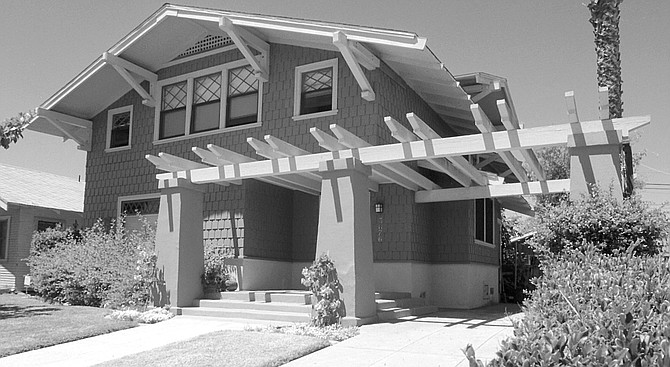
On San Diego’s midcity streets are thousands of wooden rebels. They are Craftsman homes from the early 20th Century, designed by architects in protest against Victorian excess of the past and technology’s stranglehold of the future.
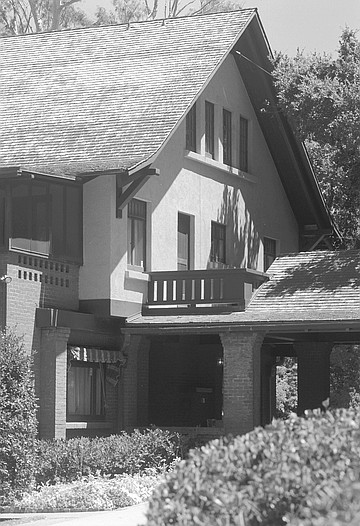
These Craftsman homes were part of the Arts and Crafts movement that swept America in the early 1900s, celebrating simplicity, hand-crafted products, and a reunion of humankind with the earth. Today, the homes are largely inhabited by Boomers, some of whom are ignorant of the houses’ provenance. But more than a few enlightened homeowners have embraced their residences’ values — both intrinsic and financial. They desire what the movement promised: an antidote to urban stresses, a “haven from the cruelties of life,” and a chance to experience — at least vicariously — a gentle, pastoral past that they imagine was better than today. Many are willing to spend heaps of wampum to bring their dreams to fruition.
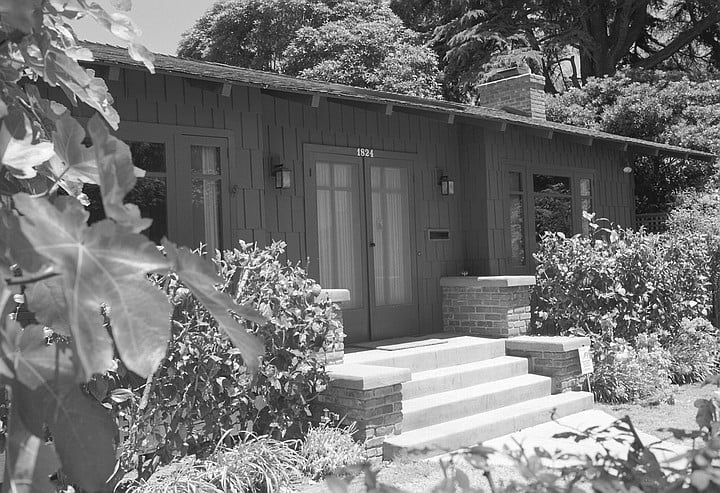
“We’re trying to do it in a pure sense,” says Ingrid Helton, a SOHO (Save Our Heritage Organisation) member and owner of a two-story 1906 Craftsman home in the Golden Hill area. She and her husband are restoring the home themselves and obtaining original Craftsman appointments, including Stickley furnishings and a stove and refrigerator from circa 1910. “We’re trying to get back to the earth, trying to be one with nature. And we appreciate what the style represents, the emphasis on things made by hand.”

Helton says she’s not alone in her zeal for that which is Craftsman. “So many people with Arts and Crafts homes in San Diego are interested in learning about their homes right now,” she says. And they’re taking steps to bring their homes back to life. “In my neighborhood, people are removing aluminum siding and stucco that was added to their houses in the 1950s and 1960s. They’re stripping the paint from their homes’ redwood shingles. And they’re pulling up wall-to-wall carpeting to expose the hardwood floors underneath.”
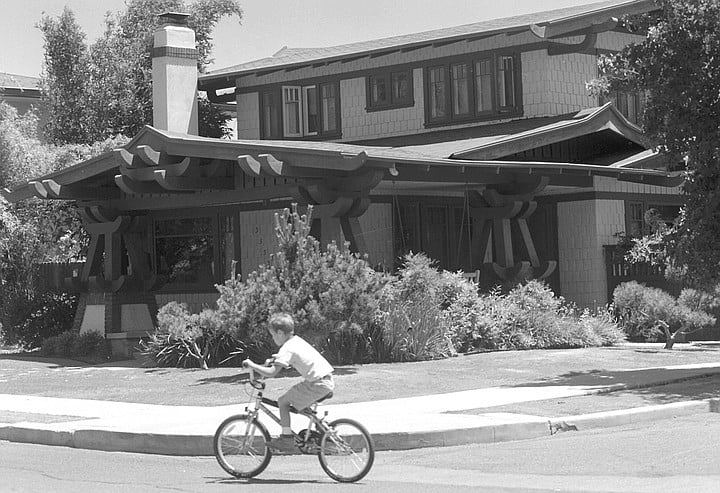
Thomas Shess, editor of the North Park News, who owns a 1915 Craftsman bungalow, concurs about the resurgent interest in San Diego’s Craftsman homes, adding, “It’s definitely picking up again. I’m a Boomer, and I’m tired of all the plastic. Boomers are starting to think about their own mortality now and what they can pass along to their children.” But Arts and Crafts zealots may have trouble finding furnishings and fixtures from the period, he warns. “Antique shops here are pretty devoid of it, because it’s been gobbled up so quickly. I believe a lot of Arts and Crafts furniture is locked up in the John Wayne generation’s closets. And I think a lot of them just don’t know what they have or what it’s worth.”
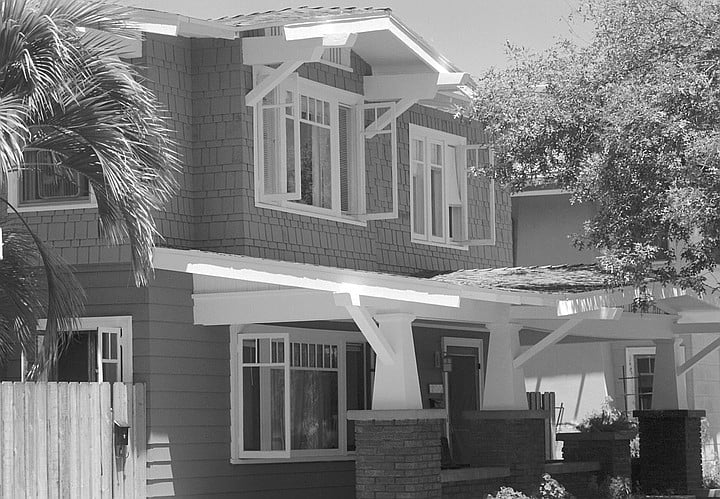
How did the rustic bungalows gain such a strong foothold in San Diego? They first overtook North Park, Hillcrest, Mission Hills, Normal Heights, Kensington, and the Balboa Park environs circa 1907, when reliable aqueducts were built in the area, and the city’s trolley lines were extended. A few Craftsman bungalows also established residence in the soils of Coronado, Chula Vista, La Jolla, La Mesa, Encinitas, and Solana Beach. They were “proletariat homes” that could be built from mail-order kits and pattern books for as little as $500. Durable, affordable, and appealing to masculine sensibilities, they propagated wildly across San Diego’s terrain until World War I.
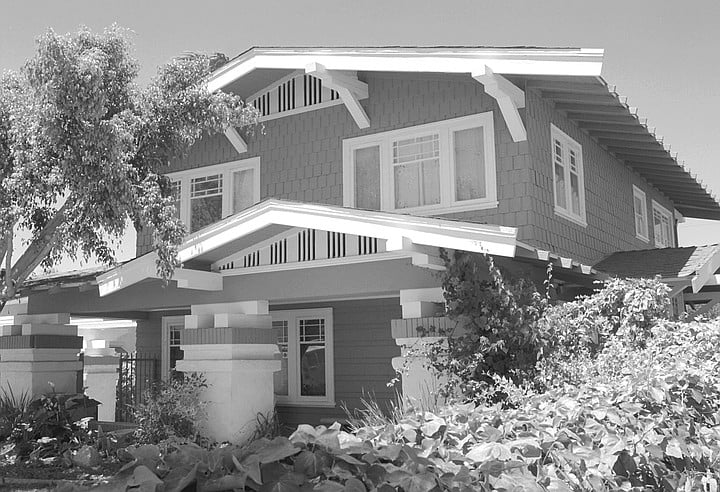
Variations of the squat, low-to-the-earth homes also began to appear throughout the countryside: Swiss-chalet bungalows with huge brick piers and flower boxes, Japanese pagoda bungalows, and even strange log houses were endorsed by noted Arts and Crafts designer Gustav Stickley in his monthly publication The Craftsman.
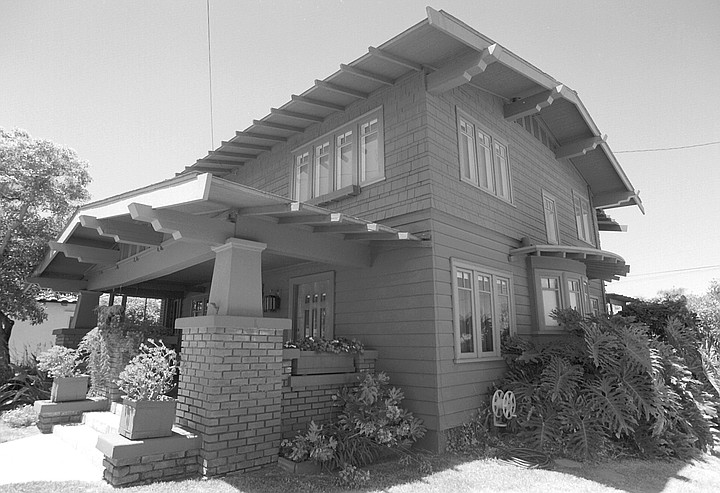
Turn-of-the-century architects, both famous and obscure, fell prey to the Craftsman’s charm and salability. Innovator Irving Gill said he aspired to produce “a perfectly sanitary, labor-saving house, one where the maximum of comfort may be had with the minimum of drudgery.” He began designing residences that reflected a spartan Prairie style in the mid-1900s. He eliminated ornamentation that was so popular in Victorian construction and instead concentrated on geometric volumes and economical home devices, such as garbage disposals that dropped waste into basement incinerators; kitchen ice boxes that opened to the outside to facilitate deliveries; and mailboxes that emptied directly into the home. Gill, a rabid enemy of dust, also created vacuum-cleaner outlets that carried dust directly to furnaces.
The best known of Gill’s San Diego Craftsman works is the 8500-square-foot Marston House, at 3525 Seventh Avenue, which he completed in 1905. The 21-room home was owned by George Marston, who operated Marston’s department store in downtown San Diego.
The store was the Neiman-Marcus of its time and the exclusive local retailer of Stickley’s line of furniture. Marston also was a Balboa Park promoter who developed a subdivision of 70 homesites in the area between 1923 and 1936. Today, the Marston House is managed by the San Diego Historical Society and is open to the public on Fridays, Saturdays, and Sundays.
David Owen Dryden, a lesser-known local architect, built more than 50 bungalows in the suburbs north of Balboa Park between 1911 and 1919. Many of the homes are still standing. He specialized in middle-class Craftsman homes for professionals and retired industrialists from the East. Usually, Dryden could complete the houses (from framing to interior finish) within six weeks.
“A Craftsman is a Craftsman is a Craftsman.”
Even the architecturally challenged can spot Craftsman bungalows. They are strong, silent, earthy, and unpretentious. They are “the result not of elaboration but of elimination,” as Stickley wrote in 1912. Most have low-pitched roofs, with widely overhanging eaves for shade and coolness. Overwide oak doors are common, too. Some Craftsman homes have pergola entrances. A few, influenced by the era’s Far East fixation, have door frames that resemble Japanese toriis (temple entrances). And others sport ponderous medieval-influenced doors fitted with heavy strap hinges of wrought iron.
Craftsman exteriors tend to be board-and-batten, fieldstone, clinker brick, or shingled in redwood, cedar, or river cypress. Roofs were frequently made of rough slate that was gray, dull red, moss green, or variegated purple in color. Ground-level porches, often of terra cotta, doubled as “outside living rooms” for the homes’ early residents. Stickley advocated furnishing these porches with willow chairs and settles, Indian rugs, and Navajo blankets.
Many two-story Craftsman houses had their upper-story walls clad in half-timber and Portland cement plaster. Second-story “sleeping porches” extended from family bedrooms and reinforced the Craftsman tradition that inside and outside should flow into each other. Larger homes often had courtyards and water gardens. Smaller homes boasted lily ponds stocked with koi or goldfish.
Gustav Stickley noted decades ago that West Coast Craftsman architects and homeowners favored stonework designs. It linked the homes to their surrounding Southern California landscape. Local builders and residents often selected rocks for their shapes and colors and then transported them to building sites by horse-drawn sleds. They collected cobblestones from rocky pastures and dry creek bottoms, gathered ocean-washed boulders from the shore, and picked up arroyo stones that could be embedded with bricks in retaining walls, to look as though they’d been haphazardly stacked by nature.
Some Craftsman builders only used split stone for their designs, as it had more interesting colors. They laid the stone in dark cement and used it in the homes’ foundations, steps, and porch parapets. In other cases, for these same jobs, builders interspersed boulders with hard-burned clinker brick and set the mix in dark mortar. Cobblestone, fieldstone, and large mossy boulders also were used for Craftsman foundations, pillars, chimneys, terraces, and retaining walls. Pathways of stone completed the effect and gently led visitors from the out-of-doors to the homes’ porches.
Landscaping of Craftsman properties was important, too, because nature was so integral to the style’s design. Informal arrangements prevailed. Some homes had rock groupings that emulated Japanese gardens. Others sported garden gateways, trellised arbors and archways, and verandas riotously covered in vines and flowers.
Inside the homes, rooms flowed together. Sometimes all that separated them were massive overhead beams. The colors that predominated were earthy, clouded, and blended.
Large windows offered ample ventilation and sunlight. Smaller windows might contain leaded art-glass or stained glass, for a warming effect. Floors were oak planking, lichen-covered flagstone, or maple, which, in some cases, was stained with vinegar and iron rust, for a comfortable rusty tone.
Craftsman walls were paneled in warm woods like gum, oak, fir, redwood, and stained chestnut. The more expensive homes’ walls might be of Burmese teak or Honduran mahogany and sport redwood friezes or inlaid decorative elements of fruitwood, ebony, oak, copper, silver, brass, and abalone shells.
Perhaps the most important interior element of the Craftsman home was the hearth — the site of family gathering—although fireplaces had been rendered superfluous by technological advances of the time. Fireplaces were wrought from split boulder, clinker brick, or Grueby or Batchelder tiles that depicted woodland, floral, and animal motifs. Some had copper hoods. Their rough bricks came in a pastiche of muted hues: subdued browns, old blues, earthy greens, burnt sienna, salmon shades, raw umber, and ochers. They blended with the colorings of other design elements in the rooms: the long, comfortable cushioned seats of the cozy inglenooks; the fumed oak benches nearby; the hammered copper-and-amber electric lanterns overhead; and the Stickley rockers that often were placed beside the hearth. Dark, heavy Craftsman oak furniture in the living areas was frequently finished in soft green or deep golden-brown tones. This area was a place for the family to assemble in the evenings, to feel at peace in the quiet of their homes, and to enjoy each other’s company before traveling up gleaming wooden staircases to their upstairs retreats.
SOHO’s Helton advises restoration-bent Boomers to think their projects out before they hire contractors or undertake the work themselves.
“Don’t do it quickly,”
Helton urges fixer-uppers. “The biggest mistake you can make in Arts and Crafts restoration is acting hastily and not researching enough. Live in the house for a while. Get to know it before starting the work.”
Following is a list of Craftsman homes in the San Diego area. Note that only the Marston House is open to the public. The other buildings below may be viewed from the street:


On San Diego’s midcity streets are thousands of wooden rebels. They are Craftsman homes from the early 20th Century, designed by architects in protest against Victorian excess of the past and technology’s stranglehold of the future.

These Craftsman homes were part of the Arts and Crafts movement that swept America in the early 1900s, celebrating simplicity, hand-crafted products, and a reunion of humankind with the earth. Today, the homes are largely inhabited by Boomers, some of whom are ignorant of the houses’ provenance. But more than a few enlightened homeowners have embraced their residences’ values — both intrinsic and financial. They desire what the movement promised: an antidote to urban stresses, a “haven from the cruelties of life,” and a chance to experience — at least vicariously — a gentle, pastoral past that they imagine was better than today. Many are willing to spend heaps of wampum to bring their dreams to fruition.

“We’re trying to do it in a pure sense,” says Ingrid Helton, a SOHO (Save Our Heritage Organisation) member and owner of a two-story 1906 Craftsman home in the Golden Hill area. She and her husband are restoring the home themselves and obtaining original Craftsman appointments, including Stickley furnishings and a stove and refrigerator from circa 1910. “We’re trying to get back to the earth, trying to be one with nature. And we appreciate what the style represents, the emphasis on things made by hand.”

Helton says she’s not alone in her zeal for that which is Craftsman. “So many people with Arts and Crafts homes in San Diego are interested in learning about their homes right now,” she says. And they’re taking steps to bring their homes back to life. “In my neighborhood, people are removing aluminum siding and stucco that was added to their houses in the 1950s and 1960s. They’re stripping the paint from their homes’ redwood shingles. And they’re pulling up wall-to-wall carpeting to expose the hardwood floors underneath.”

Thomas Shess, editor of the North Park News, who owns a 1915 Craftsman bungalow, concurs about the resurgent interest in San Diego’s Craftsman homes, adding, “It’s definitely picking up again. I’m a Boomer, and I’m tired of all the plastic. Boomers are starting to think about their own mortality now and what they can pass along to their children.” But Arts and Crafts zealots may have trouble finding furnishings and fixtures from the period, he warns. “Antique shops here are pretty devoid of it, because it’s been gobbled up so quickly. I believe a lot of Arts and Crafts furniture is locked up in the John Wayne generation’s closets. And I think a lot of them just don’t know what they have or what it’s worth.”

How did the rustic bungalows gain such a strong foothold in San Diego? They first overtook North Park, Hillcrest, Mission Hills, Normal Heights, Kensington, and the Balboa Park environs circa 1907, when reliable aqueducts were built in the area, and the city’s trolley lines were extended. A few Craftsman bungalows also established residence in the soils of Coronado, Chula Vista, La Jolla, La Mesa, Encinitas, and Solana Beach. They were “proletariat homes” that could be built from mail-order kits and pattern books for as little as $500. Durable, affordable, and appealing to masculine sensibilities, they propagated wildly across San Diego’s terrain until World War I.

Variations of the squat, low-to-the-earth homes also began to appear throughout the countryside: Swiss-chalet bungalows with huge brick piers and flower boxes, Japanese pagoda bungalows, and even strange log houses were endorsed by noted Arts and Crafts designer Gustav Stickley in his monthly publication The Craftsman.

Turn-of-the-century architects, both famous and obscure, fell prey to the Craftsman’s charm and salability. Innovator Irving Gill said he aspired to produce “a perfectly sanitary, labor-saving house, one where the maximum of comfort may be had with the minimum of drudgery.” He began designing residences that reflected a spartan Prairie style in the mid-1900s. He eliminated ornamentation that was so popular in Victorian construction and instead concentrated on geometric volumes and economical home devices, such as garbage disposals that dropped waste into basement incinerators; kitchen ice boxes that opened to the outside to facilitate deliveries; and mailboxes that emptied directly into the home. Gill, a rabid enemy of dust, also created vacuum-cleaner outlets that carried dust directly to furnaces.
The best known of Gill’s San Diego Craftsman works is the 8500-square-foot Marston House, at 3525 Seventh Avenue, which he completed in 1905. The 21-room home was owned by George Marston, who operated Marston’s department store in downtown San Diego.
The store was the Neiman-Marcus of its time and the exclusive local retailer of Stickley’s line of furniture. Marston also was a Balboa Park promoter who developed a subdivision of 70 homesites in the area between 1923 and 1936. Today, the Marston House is managed by the San Diego Historical Society and is open to the public on Fridays, Saturdays, and Sundays.
David Owen Dryden, a lesser-known local architect, built more than 50 bungalows in the suburbs north of Balboa Park between 1911 and 1919. Many of the homes are still standing. He specialized in middle-class Craftsman homes for professionals and retired industrialists from the East. Usually, Dryden could complete the houses (from framing to interior finish) within six weeks.
“A Craftsman is a Craftsman is a Craftsman.”
Even the architecturally challenged can spot Craftsman bungalows. They are strong, silent, earthy, and unpretentious. They are “the result not of elaboration but of elimination,” as Stickley wrote in 1912. Most have low-pitched roofs, with widely overhanging eaves for shade and coolness. Overwide oak doors are common, too. Some Craftsman homes have pergola entrances. A few, influenced by the era’s Far East fixation, have door frames that resemble Japanese toriis (temple entrances). And others sport ponderous medieval-influenced doors fitted with heavy strap hinges of wrought iron.
Craftsman exteriors tend to be board-and-batten, fieldstone, clinker brick, or shingled in redwood, cedar, or river cypress. Roofs were frequently made of rough slate that was gray, dull red, moss green, or variegated purple in color. Ground-level porches, often of terra cotta, doubled as “outside living rooms” for the homes’ early residents. Stickley advocated furnishing these porches with willow chairs and settles, Indian rugs, and Navajo blankets.
Many two-story Craftsman houses had their upper-story walls clad in half-timber and Portland cement plaster. Second-story “sleeping porches” extended from family bedrooms and reinforced the Craftsman tradition that inside and outside should flow into each other. Larger homes often had courtyards and water gardens. Smaller homes boasted lily ponds stocked with koi or goldfish.
Gustav Stickley noted decades ago that West Coast Craftsman architects and homeowners favored stonework designs. It linked the homes to their surrounding Southern California landscape. Local builders and residents often selected rocks for their shapes and colors and then transported them to building sites by horse-drawn sleds. They collected cobblestones from rocky pastures and dry creek bottoms, gathered ocean-washed boulders from the shore, and picked up arroyo stones that could be embedded with bricks in retaining walls, to look as though they’d been haphazardly stacked by nature.
Some Craftsman builders only used split stone for their designs, as it had more interesting colors. They laid the stone in dark cement and used it in the homes’ foundations, steps, and porch parapets. In other cases, for these same jobs, builders interspersed boulders with hard-burned clinker brick and set the mix in dark mortar. Cobblestone, fieldstone, and large mossy boulders also were used for Craftsman foundations, pillars, chimneys, terraces, and retaining walls. Pathways of stone completed the effect and gently led visitors from the out-of-doors to the homes’ porches.
Landscaping of Craftsman properties was important, too, because nature was so integral to the style’s design. Informal arrangements prevailed. Some homes had rock groupings that emulated Japanese gardens. Others sported garden gateways, trellised arbors and archways, and verandas riotously covered in vines and flowers.
Inside the homes, rooms flowed together. Sometimes all that separated them were massive overhead beams. The colors that predominated were earthy, clouded, and blended.
Large windows offered ample ventilation and sunlight. Smaller windows might contain leaded art-glass or stained glass, for a warming effect. Floors were oak planking, lichen-covered flagstone, or maple, which, in some cases, was stained with vinegar and iron rust, for a comfortable rusty tone.
Craftsman walls were paneled in warm woods like gum, oak, fir, redwood, and stained chestnut. The more expensive homes’ walls might be of Burmese teak or Honduran mahogany and sport redwood friezes or inlaid decorative elements of fruitwood, ebony, oak, copper, silver, brass, and abalone shells.
Perhaps the most important interior element of the Craftsman home was the hearth — the site of family gathering—although fireplaces had been rendered superfluous by technological advances of the time. Fireplaces were wrought from split boulder, clinker brick, or Grueby or Batchelder tiles that depicted woodland, floral, and animal motifs. Some had copper hoods. Their rough bricks came in a pastiche of muted hues: subdued browns, old blues, earthy greens, burnt sienna, salmon shades, raw umber, and ochers. They blended with the colorings of other design elements in the rooms: the long, comfortable cushioned seats of the cozy inglenooks; the fumed oak benches nearby; the hammered copper-and-amber electric lanterns overhead; and the Stickley rockers that often were placed beside the hearth. Dark, heavy Craftsman oak furniture in the living areas was frequently finished in soft green or deep golden-brown tones. This area was a place for the family to assemble in the evenings, to feel at peace in the quiet of their homes, and to enjoy each other’s company before traveling up gleaming wooden staircases to their upstairs retreats.
SOHO’s Helton advises restoration-bent Boomers to think their projects out before they hire contractors or undertake the work themselves.
“Don’t do it quickly,”
Helton urges fixer-uppers. “The biggest mistake you can make in Arts and Crafts restoration is acting hastily and not researching enough. Live in the house for a while. Get to know it before starting the work.”
Following is a list of Craftsman homes in the San Diego area. Note that only the Marston House is open to the public. The other buildings below may be viewed from the street: